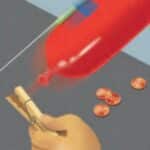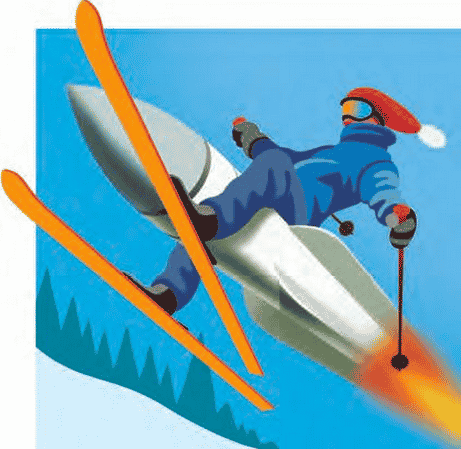Overview
STEM careers
Time
Materials
Per Class:
|
Per Team of 2-3 Students:
|
Instructions

In this activity, students make a model balloon rocket and test it out. They learn the usefulness of testing models as a part of the engineering design process, and experience Newton’s Third Law of Motion at work.
- Prepare the “test tracks”:
- Attach one end of the nylon fishing lines to high points on a wall or window at least 3 to 4 feet apart.
- Attach the other end of each to the launch table and secure them with either tape or a heavy book.
- Divide students into teams of two or three.
- Explain that a gondola-type ski lift is a passenger compartment traveling along a cable.
- Tell teams they will design a passenger carrier for a ski lift and then build and test a model. They will attach their passenger carrier to a “rocket-powered” lift.
- Demonstrate how the rocket-powered lift works:

- Run one of the track strings through a precut straw and reattach the end to the launch table.
- Inflate a balloon and secure it closed with a clothespin.
- Being sure the balloon’s opening points toward the launch table, tape the balloon to the straw.
- Release the clip. As the balloon deflates, it will push the straw to the top of the string.
- Instruct students to create a design plan for their carrier—a list of parts or a sketch—and decide how many passengers (pennies) they want their compartment to carry.
- Next, instruct students to build the carrier they designed.
- Test each finished model:
- Tell groups to decide who in their group will blow up their balloon (only one child in each group should do this).
- Using the track setups, have groups thread the
end of a string through their straw and tape their inflated balloon to the straw. Attach their passenger carrier to the lift in any way they choose, and add penny passengers. - While one child gently pulls the string taut, another lets the air out of the balloon so the lift can shoot up the string to the summit.
- Give students time to judge and discuss how well their model performed, and to identify any problems and figure out what changes they might need to make.
- As time allows, let students make changes and retest.
DESIGN AND TEST:
Guiding questions
-
Why is it sometimes good to make a model before you make the actual invention?
-
What happens to a balloon when you blow it up and then quickly let the air out? Does it travel in the same direction as the air coming out? Or the opposite?
-
Can you think of examples of something pushing backward, like air out the back of the balloon, to make an object go forward? (Think about skateboarding, swimming, rowing, etc.)
-
If your model didn’t work as planned, what exactly was the problem? (E.g., it didn’t travel all the way to the summit; it traveled too fast and crashed; passengers fell out). What changes could you make to your model to fix the problem?
Engineering & science connections
- The balloon uses the principle of propulsion to move the carrier. Engineers use propulsion to create thrust force in jet skis, jet airplanes, rockets, and missiles.
- Propulsion is described by Newton’s Third Law of Motion: For every action there is an equal and opposite reaction. The air in the balloon pushes out the back, so the balloon goes in the opposite direction.
- This activity also illustrates Newton’s First Law of Motion, which states that an object in a state of rest will remain in that state unless an external force is applied to it. The force from the air leaving the balloon must overcome the resting state of the carrier.
Cyberchase is produced by THIRTEEN in association with Title Entertainment Inc. and WNET.ORG. (c) 2009 WNET.ORG Properties LLC. All Rights Reserved. Cyberchase is a trademark of the Educational Broadcasting Corporation. Major funding for Cyberchase is provided by the National Science Foundation, Northrop Grumman Corporation, Ernst & Young LLP, PBS and the Corporation for Public Broadcasting. Additional funding is provided by The Volckhausen Family.


0 Comments